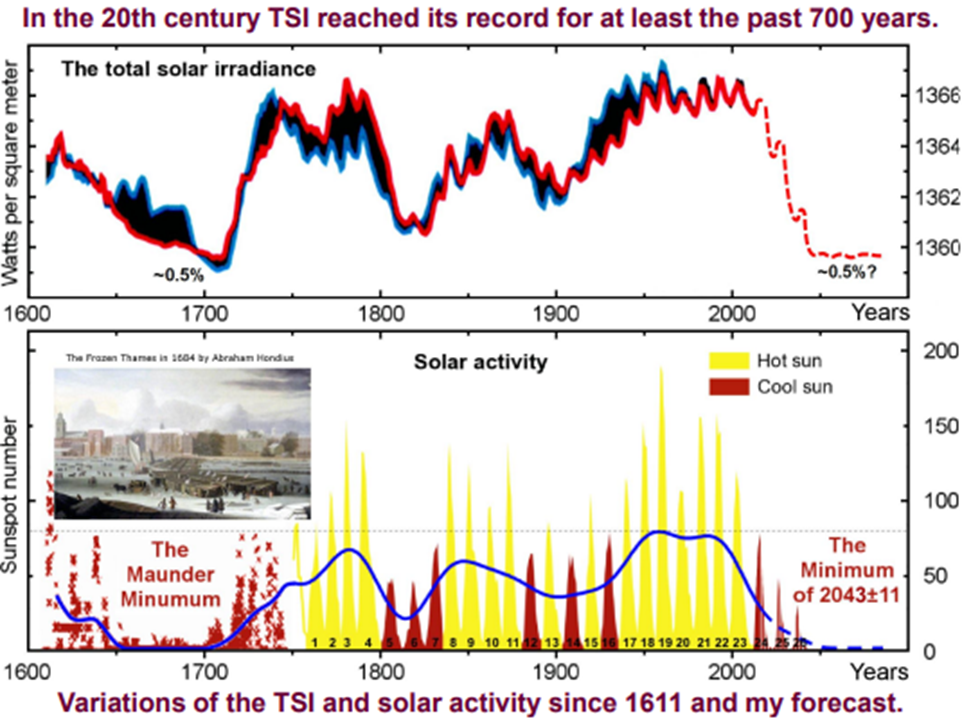Abdussamatov gave a similar talk at The Ninth International Conference on Climate Change, which took place in 2014 in Las Vegas. The conference attracted some 650 scientists, economists, policy experts and Abdussamatov's presentation was more assertive this time and was titled "2014- The Beginning of the New Little Ice Age." In that talk, he updated his estimates to the start of the Grand Minimum of TSI being anticipated by about solar cycle 27 around the year 2043 which would be followed by "a phase of deep cooling [similar to] the 19th Little Ice Age … approximately in 2060 ± 11 [years], with possible duration of 45 – 65 years." He also presented the following graph:

Abdussamatov concluded his 2014 presentation:
Advertisement
The Sun is the main factor controlling the climatic system and it is more powerful than abilities of human beings.
In 2020, Abdussamatov published a block-buster paper, "Energy Imbalance Between the Earth and Space Controls the Climate" in the journal "Earth Sciences." Once again, he did not pull his punches and repeated his forecast of a Grand Solar Minimum by about 2043. The Russian scientist slightly updated his prediction of when we could expect the next Little Ice Age to really bite hard:
Solar cooling has started. As a result, the Earth has, and will continue to have, a long negative energy balance, which will ensure a slight decrease in temperature. However, this slight decrease in temperature is extremely important as a trigger mechanism for the subsequent chain effects of secondary causal effects of feedback that will greatly enhance the cooling. This will certainly lead to the onset of a phase of deep cooling of the climate approximately in the year 2070 ± 11 [years].
and
The total rate decline in TSI from cycle to cycle is currently accelerating and will reach maximum its acceleration in the next solar cycle. The observed consistent downward trend decline of TSI in four consecutive cycles suggests that such a decrease bring backs to a similar decrease during the Maunder minimum in 1645-1715.
Some people may be tempted to dismiss Dr. Abdussamatov's forecasts, as well as the work of Svensmark, Veizer and Shaviv that I discussed in the past two articles as unique in the scientific community. However in "Modern Grand Solar Minimum will lead to terrestrial cooling" in the August 4, 2020 edition of the journal Temperature, Northumbria University professorValentina Zharkova who holds a Ph.D. from the Solar Division of the Main Astronomical Observatory, Kyiv, Ukrainewrote:
Advertisement
During this modern grand minimum, one would expect to see a reduction of the average terrestrial temperature by up to 1.0°C, especially, during the periods of solar minima between the cycles 25–26 and 26–27, e.g. in the decade 2031–2043.
And then there is the 2021 paper, "How much has the Sun influenced Northern Hemisphere temperature trends? An ongoing debate" by 23 scientists from 14 countries, the abstract of which reads, in part:
It appears that previous studies (including the most recent IPCC reports) which had prematurely concluded [that the Sun's output contributed negligibly to Earthly climate change] had done so because they failed to adequately consider all the relevant estimates of Total Solar Irradiance and/or to satisfactorily address the uncertainties still associated with Northern Hemisphere temperature trend estimates.
And I could name many more scientists who also attribute most recent climate change to variations in TSI. Contrary to the claims of climate activists that "the science of climate change is settled," the science is very much unsettled and quickly evolving in directions that will make today's climate scare look like a dangerous and expensive mistake.
Discuss in our Forums
See what other readers are saying about this article!
Click here to read & post comments.
13 posts so far.